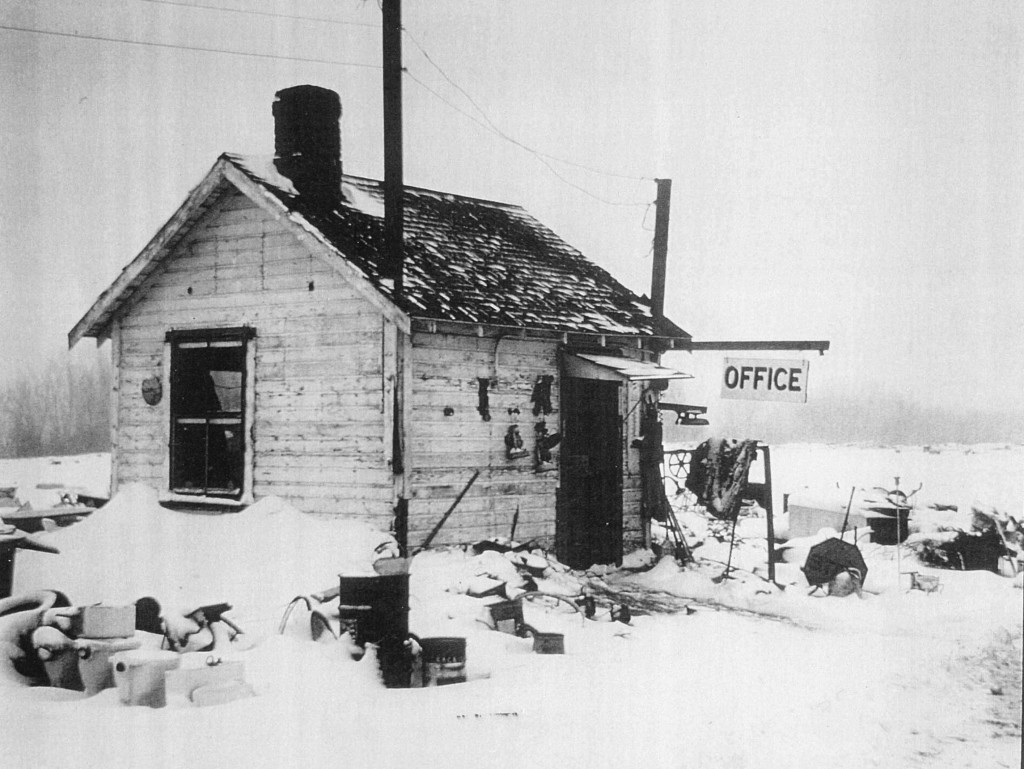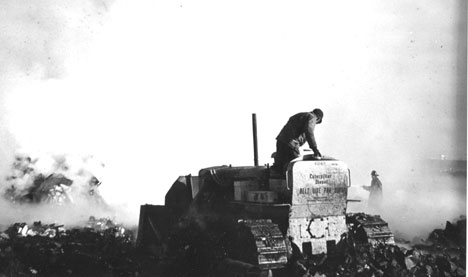On February 14, 1947, the Dispatch announced the creation of the Excelsior Blvd. Dump, located at the site of Rice Sand and Gravel, 400 ft. north of Excelsior Blvd. The plan was to charge 25 cents per load to dump a carload into the hole. The trash would be burned and leveled off to grade, starting at the south end and working northward. A license to operate the dump was given to Sam W. Elschuk, although it is indicated that the owner was a Mr. Smith and an M.M. Rude was involved. During Elschuk’s watch, someone from Minneapolis donated a washtub containing a hand grenade, small bomb, 1,000 round of 1918 Army rifle ammunition, 3 machine gun clips and assorted bullets, wrapped in a 1930 Minneapolis Journal. The police donated them right back to Minneapolis for disposal.
Complaints about the dump came right away, and after a dump fire in October 1947, the Village Council was prompted to tell Elchuk that “dumping should be done at the bottom of the hole and filled in with gravel as the pile grows up.”
Later in 1950, Ernie Jacobson – a native of Denmark – bought the 15-acre site and started the Beltline Pay Dump. Jacobson’s nephew Cliff Andreasen was a 1/3 partner. The place was, well, a dump. In June 1950 the rats were so bad that William Biehoffer, a Village-appointed, dump-paid inspector, was hired to inspect each load that came in. A 1951 article reported that the State health department found rat infestation and fly breeding on the premises and needed improvement. But Jacobson invested in heavy equipment such as bulldozers and a crane and he also planted trees. Despite his efforts, a 1952 complaint was that the dump was “an inferno of flame all summer long which smolders and smells and drives rats and insects into our homes.” Jacobson noted that permanent wave solution dumped from beauty parlors caused the most fires.

Customers were charged by the carload to unload their junk – usually 25 or 35 cents – and in an era before garage sales, often took away as much as they dumped. Cars could be disposed of as well. Six employees spent most of their time salvaging metal and other materials that could be sold. A 1954 article described some items that had been accidentally thrown away: $7,000 worth of radium (!), $1500 worth of jewelry, and a brand new casket.
In 1952 Ernie requested permission to put in a trailer house for his watchman and his wife, Mr. and Mrs. Lynn Markey.
In 1953 Jacobson requested that the west 200 ft. of 6.38 acres of the old Rice Sand and Gravel be rezoned from multiple dwelling to commercial.
In 1954 Jacobson estimated that it would take four more years to fill the place up. He proposed interim uses such as a miniature golf course or driving range until the land settled for new development. This actually came true. Eventually the dump was at capacity – the hill between Byerly’s and AAA indicates how high the pile was. When the AAA Headquarters and the St. Louis Park Health Center (later Park Nicollet and so on) were built on the site, the buildings started to sink and elevators started to stink – as they filled with methane gas. Both problems were fixed, but such are the hazards of building on mounds of trash.

Here’s an article about the Dump written by Bob Reiss for the Summer 2003 edition of the Re-Echo:
ERNIE’S BELTLINE PAY DUMP
Taking your disposables to Ernie’s Beltline Pay dump was a fun experience for many people. Even today, when reminded about the dump, they smile and say, “Sometimes we brought back for than we left.”
In about 1954, Ernie’s Beltline Pay Dump was located in the northeast corner of Excelsior Boulevard and Highway 100. The entrance to the dump was at the northeast corner of Highway 100 where Wooddale, at that time, crossed at grade level. Wolfe Lake (then Johnson Lake) was its eastern border. It was right in the center of what is now downtown St. Louis Park!
The site started out as a potato field but in the 1940s, Rice Sand and Gravel excavated sand to approximately the same elevation as Byerly’s and the Target store. Dumping eventually filled it back up to its current level.
“Ernie” was Ernie Jacobsen, who with his partner, Cliff Andraessen, were the owners and operators of the dump. They took over the ownership in 1952 from William Smith after the City fathers threatened to close it down because it was a nuisance.
Ernie and Cliff were determined to be good neighbors. They drilled a well and used water to keep the dust down. They allowed no garbage to be dumped. They bought bulldozers and graders and made sure they ran a clean dump. They sprayed for flies and provided rat control. They planted trees and bushes to make the place look better.
The original plan was to fill the land back up to its original elevation so it could be used for commercial development and make a profit selling the land. Between the dumping fees (35 cents per carload) and the salvage, the dump turned out to be very profitable. Sometimes as many as six people were employed to pick out the copper wire, aluminum pots and pans, cast iron, steel and rags that were thrown away. The dump made the partners a great deal of money.
A story that may be true is that Ernie, in his dirty overalls, came into a real estate office to buy a house. No one recognized him and none of the four agents wanted to be bothers with this type of customer. Imagine their surprise when he paid cash for the house he purchased. Ernie and Cliff thought that people were very careless about what they threw into the dump. They spent many hours searching through the trash to find diamonds, $100 bills, valuable scientific instruments, wallets and a wide variety of things that were accidentally thrown out. Many of these items were never found and are still buried there. The most expensive item that was never found was $7,000 worth of radium lost by a medical firm. It had been sealed in a lead box and was never found even though Geiger counters were used in the hunt.
The biggest mystery was a full size casket that showed up. Many caches of jewelry settings without stones were found and assumed to be from stolen jewelry. There is probably more history buried in this land than we have in the Historical Society.
In 1959 the dump reached its capacity and was closed. Ernie and Cliff started another dump but were not as lucky or successful, perhaps because of location.
AAA and Park Nicollet purchased six acres on this site in 1966 and built their respective buildings. Ernie Jacobsen successfully ran for the Minnesota Legislature and served St. Louis Park very well.
